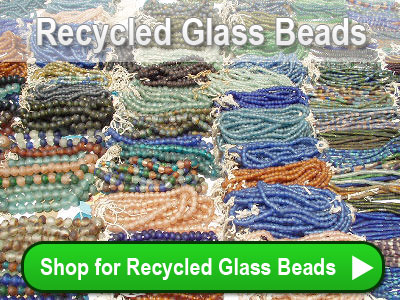Krobo Recycled Glass Beads
Krobo Recycled glass beads are beads made from recycled glass by the Krobos of Ghana in the area around Krobo Mountains. The Krobo Recycled glass beads have been manufactured for many years and they are still made in open-sided huts that are thatch-roofed. The beads are still made in the traditional labor-intensive method.
Krobo recycled glass beads are wonderfully colored. The recycled glass in sheet or shard form is crushed into powder form before beads can be made. This is done using a mortar and pestle and it is mostly the men who do this. After the crushing, the powder is sifted to remove all large chunks. Some ceramic powder is added to the powder to intensify the color. The powder is then poured into cylinder-shaped holes made into clay molds. The clay used is locally dug. Bead holes are made from cassava sticks inserted into the center of the molds.
The name of this technique is ‘vertical-mold dry powder glass technique’. The cassava sticks are burnt during the firing process and this leaves a hole in the center of the bead. However, some Krobo recycled glass beads get perforated after the firing process. This is achieved by piercing the glass while it is still hot using pointed metal tools.
For the best beads, the temperature used in firing has to be just right. The firing is done in clay kilns made from termite clay. The clay kilns are handmade and the fire is fed using small logs. The molds are inserted into the kiln using long-handled tools that look like spatula. On reaching a putty consistence, the beads are removed and using tools that look like ice picks, they are loosened from the mold. The beads are shaped by pressing them down one at a time to give them a slight curve. For translucent beads, the temperature required is 850 to 1000 deg. Celsius and it takes between 35 and 45 minutes. For powder glass beads, the temperature required is 650-800 deg. Celsius and it takes between 20 and 30 minutes.
After this, the beads are cooled and washed and the painstaking process of painting begins. The painting is done with a thin wooden stalk using a paste made from colored glass powder dissolved in water. The designs are highly individualized and it means no two Krobo recycled glass beads are the same. Different colors are used for each bead. After the painting, the beads are re-fired to make the colors permanent.
Modern Krobo recycled glass bead making uses three distinct styles. The style used depends on the area of Krobo country where the beads are made. In one style, translucent or semi-translucent beads are made by the fusion of large bottle glass or glass bead fragments. With this style, the perforation is done after firing, as is the shaping of the beads. In another style, pulverized glass is used to make spheres or bicones. The two halves are then joined in another firing process to give the bead. In the last style, the beads are made from finely ground glass and they have glass slurry decorations and the fusion is done in the second firing. The beads produced this way are called writing beads, or Mue ne Angma.
In most cases, Krobo recycled glass beads are strung as double circlets that are larger than an average bracelet on a cotton string and tied off with triple knots before they are sold.

{ 1 comment… read it below or add one }
Hi,
Based on what you have written indicate that you have been to Krobo really but you were not able to meet most of the recycled glass bead makers who have the intense knowledge and technology in reproducing the ancient krobo beads.They are scattered around the krobo towns but due to financial constraints they are not known globally.I would be grateful if we link up to make krobo bead production a plus across the globe.
Thanks
Ruddy